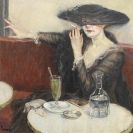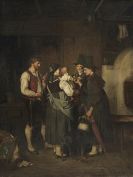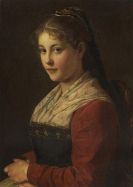
Auguste Rodin
Paris
1840 -
Meudon
1917
The French sculptor, illustrator, graphic artist, and painter François Auguste René Rodin was born on November 12, 1840 in Paris. He is considered to be the founder of Impressionist style in the art of the sculpture. During his studies at the École Impériale Spéciale de Dessin et de Mathématiques (called La Petite École) in the years 1854 – 1857, Rodin attended classes by Lecoq de Boisbaudran and Jean-Baptiste Belloc. After he discovered his interest in sculpting, he made three attempts to be accepted at the École des Beaux-Arts, but failed the entrance examination.
In the following years, the artist worked for various decorators and decoration painters. When his sister Maria died in 1862, Auguste Rodin fell into a personal crisis and joined the order of the Pères du Très-Saint Sacrament. However, the abbot soon encouraged him to devote his life to art. Starting in 1864, the artist worked for the sculptor Albert Ernest Carrier-Belleuse (1824 – 1887) and was his student. That same year, he met his life companion Rose Beuret, who he did not marry until 1917. In 1870, Rodin followed Carrier-Belleuse to Brussels. However, the paths of the sculptors soon separated again after intense clashes. In the following period, Auguste Rodin accepted public commissions and worked as an assistant to the Belgian sculptor Antoine Joseph van Rasbourg (1831 – 1902). During the years 1875-76, he took a trip to Italy in order to study the works of Michelangelo and Donatello.
Rodin succeeded in his breakthrough as a sculptor with "The Age of Bronze" (1876). In order to study the Gothic cathedrals, he traveled through France in 1877 and published the treatise "Les Cathédrales de France", which contains his studies of architectural details and observations about the Gothic style in 1914. From 1879 – December 1882, the artist worked in the porcelain factory in Sèvres. During this time, he received the state commission for "The Gates of Hell", the portal for the Musée des Arts décortaifs in Paris with the theme of "Dante’s Inferno". Although the work on it lasted until Rodin‘s death, it could not be completed. The figures "The Kiss", "Ugolino", "Adam", "Eve", and "The Thinker" are seen as independent works. In 1883, Auguste Rodin met the French sculptress Camille Claudel (1864 – 1943), who was initially his student and his mistress until 1898. In 1885, he received the commission for the bronze figure group "The Burghers of Calais" (erected in 1895). Another state commission followed in 1889 for the sculpture of Victor Hugo (unfinished) for the Pantheon and the sculpture of Claude Lorraine (erected in 1892 in Nancy). In addition, Rodin received the commission for a monument of Honoré de Balzac (1892 – 97) in 1891 from the Société the Gens de Lettres.
In 1894, the artist moved to Meudon. During the following period, he participated in many exhibitions (Prague, Düsseldorf, Paris, Vienna, Leipzig, Tokyo, New York, Lyon, etc.) and received honorary doctorates from the Universities of Glasgow (1906) and Oxford (1907). He also participated in the World Exhibition in Paris in 1900 with 171 works. In the years 1905-06, Rainer Maria Rilke (1875 – 1926) worked as Auguste Rodin’s private secretary and wrote a biography of the artist. In 1907, the sculptor moved into his city studio at the Hôtel Biron, where he lived until his death. Because three of his works were given as gifts to the French state (1916), it was possible to open the Musée Rodin here in 1919.
François Auguste René Rodin died on November 17, 1917 in Meudon.
Would you like to sell a work by Auguste Rodin?
Infos for seller




